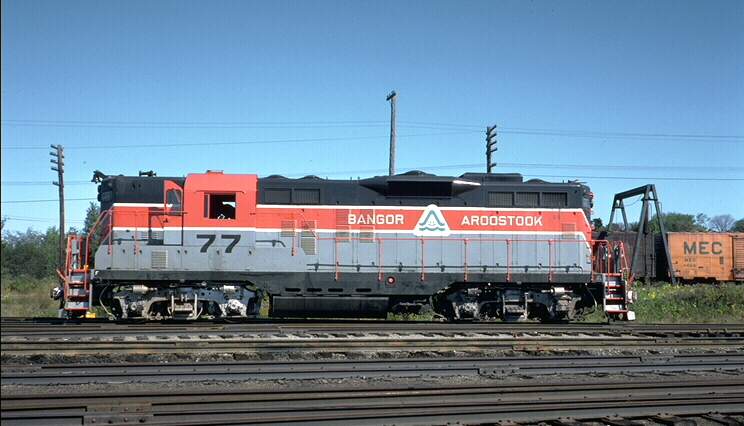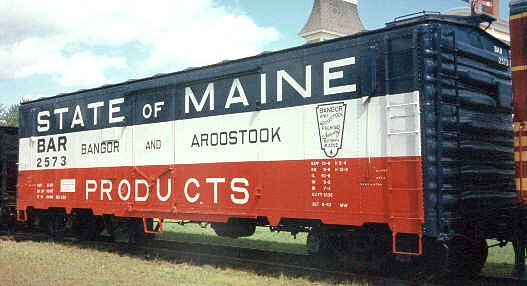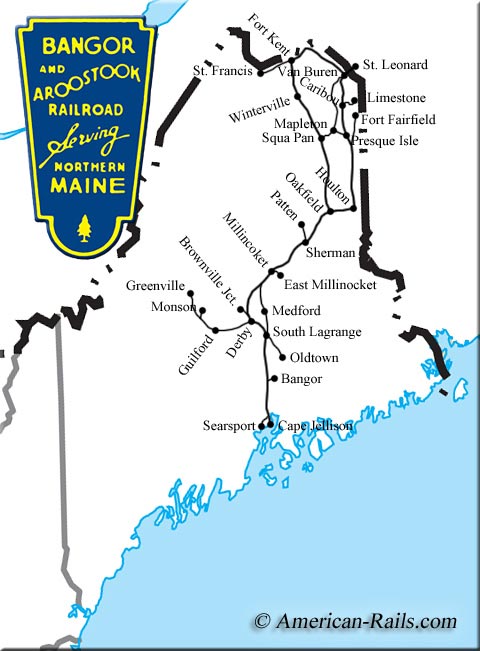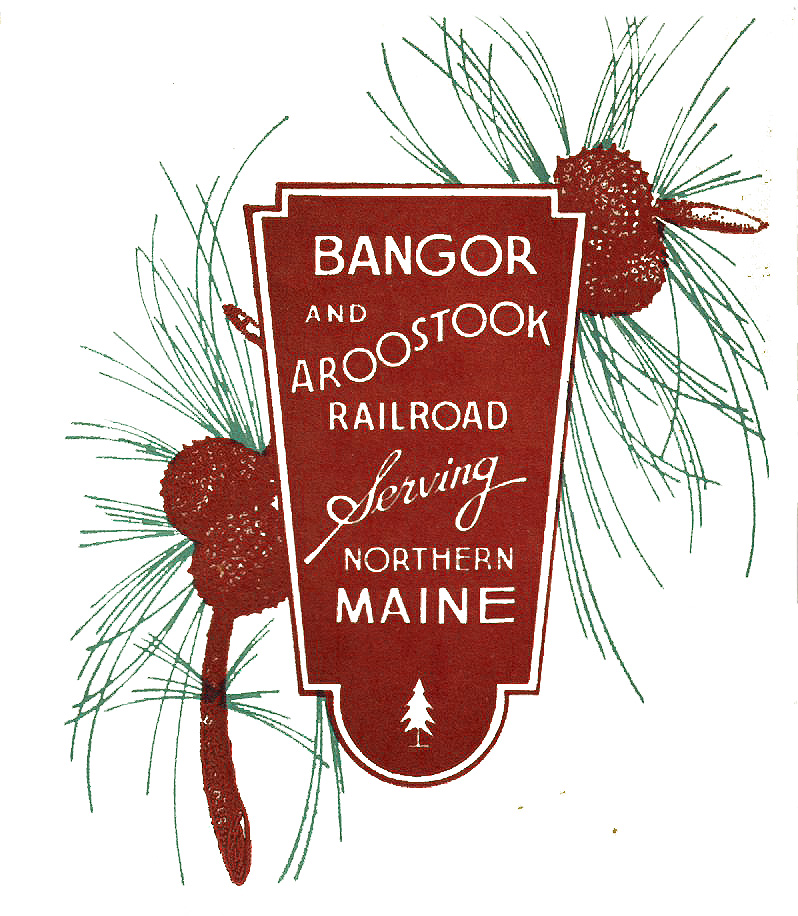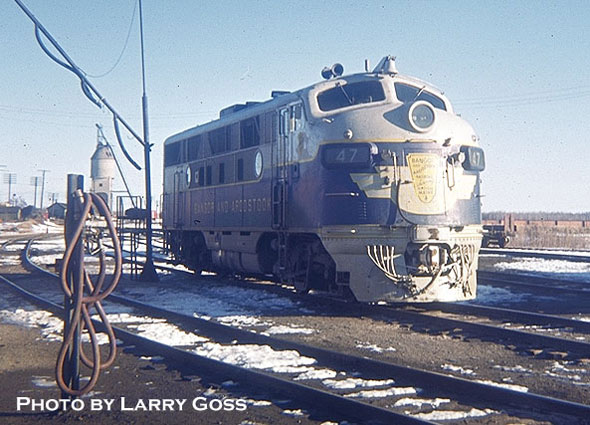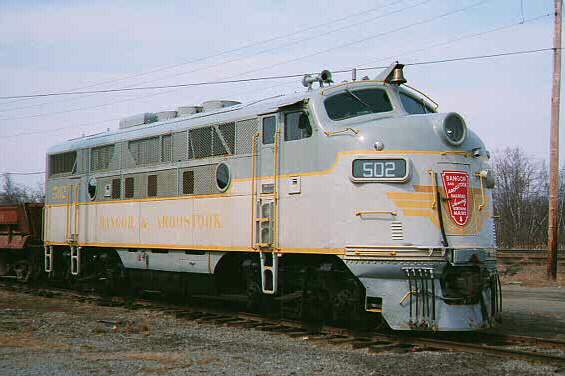Bangor and Aroostook Railroad
The Bangor and Aroostook Railroad ( BAR, also B & A) is a former railway company in the United States. It was founded on February 3, 1891, operating 873 km standard gauge railway lines in the State of Maine. In Greenville Junction, Brownville Junction, Presque Isle and Houlton, there were links to the Canadian Pacific Railway, St Leonards for Canadian National Railway, Northern Maine Junction and Oldtown to the Maine Central Railroad. The company's headquarters was in Bangor. Since 2003, the network of BAR to Montreal, Maine and Atlantic Railway heard.
- 6.1 References
- 6.2 Literature
- 6.3 External links
History
The company was primarily established to link the north-east of the State of Maine on the railway network, as well as the investments of the Bangor and Piscataquis Railroad ( Route Greenville- Old Town) and the Bangor and Katahdin Iron Works Railway ( Route Milo Junction Katahdin Iron Works ) combine and take over. Construction began in Brownsville and in 1893 reached the track Houlton. The flat landscape presented here represent a much smaller problem than the severe and snowy winter.
The Bangor & Aroostook leased on 27 November 1897, the Aroostook Northern Railroad, which ran a distance of Caribou by Limestone and bought it on July 1, 1901 final on. On the same day acquired the BAR and the Patten and Sherman Railroad. The Fish River Railroad, which had the Ashland Branch of the BAR extended to Fort Kent, was acquired in July 1903. In November 1906, the BAR took over the Schoodic Stream Railroad and leased on July 7, 1907, the Northern Maine Seaport Railroad ( NMSRR ).
The network of BAR was completed in 1910 with the gap closing between Grand Isle and Fort Kent. To obtain a further connection to the Canadian rail network addition to the connections in Fort Fairfield and Houlton, the BAR founded on 30 January 1913, the Van Buren Bridge Company, who opened the railway bridge from Van Buren to the Canadian St. Leonards on 1 May 1915.
The mid- 1910s planned Allagash Line, which should be followed in Packards on the main line and should lead parallel to the Allagash River to the ends of the branch line to St. Francis, was not built. You would have opened up to the present day almost uninhabited north-west of the state.
In fiscal year 1909/10 the BAR had 93 locomotives and 5576 wagons (of which 5,400 wagons). The complete conversion to diesel locomotives was completed in 1952. The last passenger train ran on September 4, 1961.
From 1964 to 1969, the Bangor Punta owned the railway company. Then the shares were resold to the Amoskeag Company. In 1995 the company was taken over by the Iron Road Railways, but went bankrupt in 2002. On 9 January 2003, the bankruptcy estate was acquired by Rail World Inc. and reorganized as Montreal, Maine and Atlantic Railway. 2006 consisted of the main route or the sections Brownsville Houlton, Phair Caribou and Van Buren -Fort Kent and beside the tracks Brownsville-South Lagrange Searsport, Oakfield -Fort Kent, Squapan - Presque Isle and Van Buren -St. Leonards and the random routes to Brownsville Junction, East Millinocket, Limestone and Fort Fairfield. The last two lines are no longer connected by the former main line with the rest of the network, but over Squapan.
Route network
The routes of the BAR are mostly single track. Only the portion of Northern Maine Junction - South Lagrange and the short distance piece Packards - West Seboeis were expanded to double track, however, have been now scaled back on single track lines.
The following railway lines belonged to the network of the Bangor & Aroostook ( from south to north ):
- Railway South Lagrange Searsport (operating)
- Railway Junction Cape - Cape Jellison ( decommissioned)
- Railroad track Old Town -Greenville (operating between South Lagrange and Milo Junction )
- Railway Derby Katahdin Iron Works ( in operation until Brownsville Junction )
- Railway South Lagrange -Packard (closed)
- Railway Brownsville -Saint -Leonard ( in operation until Houlton, between Phair and Caribou and from Van Buren )
- Railway Bowden East Millinocket (operating)
- Railway junction Patten Patten ( decommissioned)
- Railway Oakfield -Fort Kent (operating)
- Railway Squa Pan -Stockholm (operating between Squa Pan and Mapleton )
- Railway Mapleton - Presque Isle ( in operation)
- Railway Phair Fort Fairfield (operating)
- Railway Caribou Limestone (operating)
- Railway Van Buren -Saint Francis ( in operation to Fort Kent)
Vehicle park
Steam locomotives
The Bangor & Aroostook acquired at the beginning of operation, the then customary steam locomotives with the wheel arrangement 2'B. Some were already over 20 years old. Until the beginning of the 20th century this type was procured, plus various types of locomotives 1'C, 2'C and C. In 1907 then the procurement of three type locomotives, "Consolidation " ( 1'D ). Fulfilled These locomotives the expectations placed upon them, so that until 1945 still 24 more locomotives of this type were ordered. however in freight train through traffic they were replaced from 1929 by 2'D1' locomotives from ALCO ( M series ). the locomotives of this series were very easily constructed and undercut even the similar construction of the USRA. , 1945, the last new locomotives and a year later purchased the last used locomotives.
For passenger transport, especially type locomotives 2'C were in use. In 1927, they released five " Pacifics " ( 2'C1 ') of the F series to do so.
The last regular -operated with a steam engine train ran on 22 July 1951.
Diesel locomotives
In July 1946, an EMD F3 was used to test drives. Due to the large savings potential that it became clear the locomotive pool in a relatively short time it was decided to switch to diesel locomotives. 1949, the change was more or less completed, just for the increased demand in winter steam locomotives were still used. Diesel locomotives, which were not needed in the summer, you let to the Pennsylvania Railroad.
The first vehicles it was diesels types EMD F3 EMD BL2 and, later, the EMD GP7 types, GP9 and GP38 came at that. These were also up for sale Bangor & Aroostook of the Iron Road Railways in use.
Passenger
In sparsely populated north of the State of Maine from the beginning was little demand for passenger trains. The BAR therefore pointed to the operational peculiarity that they basically offered on Sundays no passenger. Through trains on the Maine Central Railroad to Portland and on to Boston it was only in the 1920s. The two express trains BAR drove from Bangor to Houlton on Van Buren. Until the termination of passenger service on this route about 1930 one of the express trains ran on the shortcut route in Medford. The express trains came a passenger train Bangor Caribou and other passenger trains on shorter routes.
On most Zweigstrecken drove two to four daily hours of pairs of passenger, mostly as a Mixed Trains. It is worth noting were the pairs of trains Houlton - Ashland -St. Francis and Squa Pan - Van Buren -Fort Kent who were on these routes each single trains with passenger transport. As early as 1930, the passenger traffic on the routes Bangor Searsport, South Lagrange Old Town, South Lagrange -Packard and Brownsville Junction Katahdin Iron Works was discontinued. The remaining network followed until 1961.
The travel time on the main line was in 1913 from Bangor to Van Buren about eight to nine hours. The passenger Houlton -St. Francis took 7.5 hours for the distance of Squa Pan to Fort Kent (over Van Buren ) it was a five hour journey.
Special events
From major railway accidents The BAR was spared. However, the headquarters of the BAR was destroyed by a major fire in Bangor on April 30, 1911.


